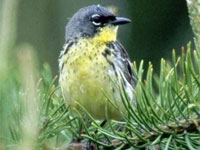
Dave Ewert isn’t the first to say that the recovery of Michigan’s Kirtland’s warblers has been phenomenal or that 2011 was a record year for the endangered bird.
That’s when state and federal biologists, researchers and volunteers observed 1,805 singing males, up from 1,747 in 2010.
Both counts are well above the state’s recovery goal of 1,000 breeding pairs and light-years beyond historic lows in 1974 and 1987, when 167 singing males were found.
But when Ewert, the senior conservation scientist for the Nature Conservancy in Michigan, speaks at the annual Tawas Point Birding Festival, set for May 17-20, he will talk about an aspect of the warbler’s recovery that few get to hear — the Bahamas connection. On that he is an expert, having studied the warbler’s wintering behavior on the islands for nearly a decade.
“Kirtland’s warblers are found throughout the Bahamas,” Ewert said in a phone interview, having just returned from the islands. “Our study has focused on the island of Eleuthera, but we’re starting to go out to others and have found them on Long Island, Exuma, Abaco and New Providence.”
The Bahamas connection is an important one: The warblers winter there. If their island habitat or food supply disappears, the diminutive birds will not thrive. Conservation scientists say it is not enough to provide habitat and manage for them on their summer nesting grounds in Michigan.
Ewert’s research has shown the warblers favor island sites that have been bulldozed or burned, where they find dense shrub communities such as black porch, a small shrub with purple-black berries or, in the fall, snowberry and, later on, wild sage.
Through grants and relationships with the Bahamian government, Ewert and his colleagues from the U.S. Forest Service, the Institute of Tropical Forestry and the Bahamas National Trust are working to establish better warbler conservation practices on the islands.



